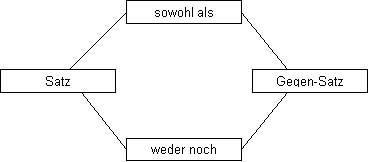Basics of the Diamond Technique
The Diamond Technique is a wonderful complement to other NLP techniques. It can be used both as a problem-solving and as a creativity method. Its purpose is not necessarily to solve problems, but to dissolve them — that is, to gain completely new perspectives and insights, which often result in the problem being perceived or understood differently.
Diamond Technique: Level I
This section introduces the basic Diamond. Later, this can be expanded into complex Diamond networks.
Step 1: From Problem to Goal
The starting point of the Diamond Technique is a problem or limitation. This leads to a goal to be achieved. This goal should be well-formed, meaning it should be positive, concrete, and under your own control.
- Is it within your power to achieve this goal?
- What can you do to reach your goal?
- If you had already achieved your goal, what would that mean for you?
- Is it allowed to happen? …
At the beginning of the Diamond Technique, you always start with a statement (e.g. “I lose at chess”) and then form an opposing statement (e.g. “I win at chess”). This opposing statement usually represents a negation of the first.
There are two types of negation:
Negation 1: lose – not lose
Negation 2: lose – win
A first-level negation would contradict the principle of a well-formed goal since goals should be stated positively. The counter-statement does not always have to be a direct negation — it can also simply represent a contrast between two different moments.
Step 2: Discovering the “Both-And”
What includes both the statement and the counter-statement? In simpler terms, the next Diamond question is:
“What do the problem and the goal have in common?”
“What is the common ground between losing and winning?”
Answering this question requires entering a completely new dimension of problem understanding. The client dissociates from their problem.
Clear distinctions between good and bad begin to blur. This happens naturally through the very form of the question, without needing to be explicitly addressed. This is an important step toward dissolving the problem.
Problem-solving: reaching a goal within the existing framework.
Problem-dissolving: leaving the framework altogether.
In the example of losing and winning in chess, a “both-and” might mean recognizing that in every game, someone wins and someone loses, or it ends in a draw — it is always a zero-sum game.
Step 3: Discovering the “Neither-Nor”
What is neither the problem nor the solution?
What lies beyond statement and counter-statement?
What lies beyond problem and solution?
In the chess example, it might mean that the game was enjoyable regardless of whether you won or lost. This perspective helps to relativize the problem and opens space for new possibilities. This step also makes the Diamond Technique an excellent tool for creativity.

A figure with these four elements is called a Diamond. The Diamond Technique involves creating such Diamonds. After fully experiencing each of the four points, you can move from one Diamond point to another.
Level II of the Diamond Technique
Basics of the Diamond Technique
The Diamond Technique is a wonderful complement to other NLP techniques. It can be used both as a problem-solving and as a creativity method. Its purpose is not necessarily to solve problems, but to dissolve them — that is, to gain completely new perspectives and insights, which often result in the problem being perceived or understood differently.
Diamond Technique: Level I
This section introduces the basic Diamond. Later, this can be expanded into complex Diamond networks.
Step 1: From Problem to Goal
The starting point of the Diamond Technique is a problem or limitation. This leads to a goal to be achieved. This goal should be well-formed, meaning it should be positive, concrete, and under your own control.
- Is it within your power to achieve this goal?
- What can you do to reach your goal?
- If you had already achieved your goal, what would that mean for you?
- Is it allowed to happen? …
At the beginning of the Diamond Technique, you always start with a statement (e.g. “I lose at chess”) and then form an opposing statement (e.g. “I win at chess”). This opposing statement usually represents a negation of the first.
There are two types of negation:
Negation 1: lose – not lose
Negation 2: lose – win
A first-level negation would contradict the principle of a well-formed goal since goals should be stated positively. The counter-statement does not always have to be a direct negation — it can also simply represent a contrast between two different moments.
Step 2: Discovering the “Both-And”
What includes both the statement and the counter-statement? In simpler terms, the next Diamond question is:
“What do the problem and the goal have in common?”
“What is the common ground between losing and winning?”
Answering this question requires entering a completely new dimension of problem understanding. The client dissociates from their problem.
Clear distinctions between good and bad begin to blur. This happens naturally through the very form of the question, without needing to be explicitly addressed. This is an important step toward dissolving the problem.
Problem-solving: reaching a goal within the existing framework.
Problem-dissolving: leaving the framework altogether.
In the example of losing and winning in chess, a “both-and” might mean recognizing that in every game, someone wins and someone loses, or it ends in a draw — it is always a zero-sum game.
Step 3: Discovering the “Neither-Nor”
What is neither the problem nor the solution?
What lies beyond statement and counter-statement?
What lies beyond problem and solution?
In the chess example, it might mean that the game was enjoyable regardless of whether you won or lost. This perspective helps to relativize the problem and opens space for new possibilities. This step also makes the Diamond Technique an excellent tool for creativity.

A figure with these four elements is called a Diamond. The Diamond Technique involves creating such Diamonds. After fully experiencing each of the four points, you can move from one Diamond point to another.
Level II of the Diamond Technique
Practical Notes
- Especially when asking about what is prevented, ensure that the client’s answer carries a genuinely positive meaning. (If in doubt, ask follow-up questions.) For example, little is gained if, when asked what one’s professional commitment prevents, the answer is “the risk of unemployment.” That does not reveal any real trade-off, and the old good/bad dichotomy remains intact. A true trade-off only becomes clear when something of genuine personal value is mentioned, such as “time with family.”
- The Diamond is most transformative when the points mentioned hold both cognitive and emotional meaning for the client. When treated only intellectually or purely emotionally, the Diamond’s potential impact remains limited.
- If both cognitive and emotional aspects are present, it is useful to work with nouns or nominalizations (contrary to usual NLP practice). This not only makes note-taking simpler and clearer but also helps avoid drifting into long explanations that move away from the essence. The Diamond format is most effective when the user stays centered within their own inner landscape. This enhances the precision and efficiency of the coaching process.
- Allow the client time to reflect before answering. If the process is rushed, it usually has little impact. In truly effective Diamond interventions, there is often at least one moment when the client pauses to reflect deeply. Such moments should never be interrupted—avoid “helping” by suggesting answers.
Learn more about the Diamond Technique in the online seminar recording with Stephan Landsiedel.

 Deutsch
Deutsch English
English Français
Français 中文
中文 Español
Español नहीं
नहीं Русский
Русский
